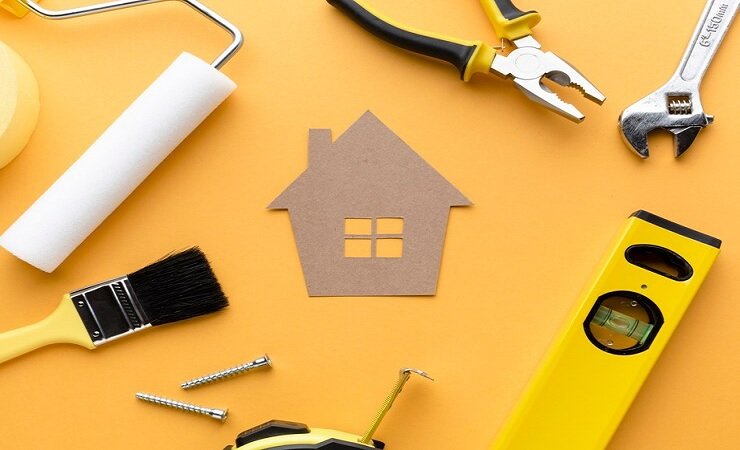How to Create a Home Improvement Schedule
Today, we’re going to dive into the exciting world of home improvement and renovation. Hold on tight, because this is going to be one wild ride!
Have you ever looked around your home and thought, “Man, this place could use a little TLC”? Maybe your kitchen is stuck in the 90s, or your bathroom feels more like a time capsule than a relaxing oasis. Well, my friends, you’re not alone! Maintaining and improving our homes is an ongoing journey, but one that’s absolutely worth the effort.
By following a well-planned home improvement schedule, homeowners can ensure their homes remain safe, functional, and aesthetically pleasing while also saving time and money. Trust me, having a game plan is the key to unlocking the full potential of your dream home.
Key Takeaways:
- A home improvement schedule helps prevent costly repairs down the line.
- It maintains and even increases the value of your home.
- Safety and functionality are top priorities.
- Proper planning reduces stress and anxiety.
- An organized approach enhances your overall quality of life.
Why Create a Home Improvement Schedule?
Let’s be real, owning a home is a big responsibility. It’s not just about having a roof over your head – it’s about maintaining and nurturing your investment. Creating a home improvement schedule might sound like a chore, but trust me, it’s a game-changer.
- Preventing Costly Repairs: By staying on top of regular maintenance and addressing issues early on, you can avoid those dreaded “surprise” expenses that can put a serious dent in your wallet.
- Maintaining Home Value: We all want our homes to be worth top dollar, right? A well-maintained home not only looks great but also holds its value better when it comes time to sell.
- Enhancing Safety and Functionality: Your home should be a safe haven, not a ticking time bomb. Regular check-ups and repairs can catch potential hazards before they become a problem and keep your home running smoothly.
- Reducing Stress and Anxiety: Let’s be honest, dealing with a sudden plumbing disaster or a leaky roof is enough to send anyone’s stress levels through the roof. A solid home improvement schedule can help you stay ahead of the curve and keep your cool.
- Improving Overall Quality of Life: When your home is in tip-top shape, it just feels good. You’ll enjoy your living space more, and that positive energy can ripple into other areas of your life.
Assessing Your Home’s Needs
Before you start mapping out your home improvement schedule, it’s crucial to take a good, hard look at your home’s current condition. Think of it as a full-body checkup for your humble abode. 🏠
- Identifying Safety and Structural Issues: Start by addressing any glaring safety or structural problems. We’re talking about things like loose railings, cracked foundations, or outdated electrical systems. These issues should be at the top of your priority list.
- Evaluating High-Traffic Areas: Pay close attention to the areas of your home that see the most wear and tear, like entryways, hallways, and kitchens. These spots might need a little extra TLC to keep them looking sharp.
- Considering the Return on Investment (ROI): Let’s be real, not every home improvement project is created equal. Some projects, like kitchen or bathroom renovations, can significantly increase your home’s value, while others might just be for your personal enjoyment.
- Determining Your Budget and Energy Efficiency Goals: Before you start knocking down walls, take a good look at your budget and how much you’re willing (or able) to invest. Also, consider energy-efficient upgrades that can save you money in the long run while being kinder to the environment.
Creating Your Schedule
Alright, now that you’ve got a solid understanding of your home’s needs, it’s time to start crafting your home improvement schedule. Think of it as your roadmap to renovation bliss!
- Prioritizing Tasks: Make a list of all the projects you want to tackle, big and small. Then, prioritize them based on urgency and importance. Safety issues should always take precedence, followed by major structural or functional upgrades.
- Breaking Down Large Projects: Some projects, like a full kitchen remodel or adding an addition, can seem overwhelming. The key is to break them down into smaller, more manageable tasks. That way, you can tackle them one step at a time without feeling overwhelmed.
- Setting Realistic Timelines and Deadlines: Be honest with yourself about how much time and effort each project will require. Setting realistic deadlines will help you stay on track and avoid burnout.
- Considering Your Lifestyle and Personal Preferences: Your home improvement schedule should align with your lifestyle and personal preferences. If you love to entertain, prioritize projects that enhance your living spaces. If you’re a busy professional, consider low-maintenance upgrades that require minimal upkeep.
Tips for Staying on Track
Even with the best-laid plans, it’s easy to get sidetracked or lose momentum when it comes to home improvements. That’s why it’s essential to have a few tricks up your sleeve to keep you on track.
- Using Digital Tools and Reminders: In today’s tech-savvy world, there’s no shortage of apps, calendars, and digital tools to help you stay organized and on schedule. Set reminders, track progress, and stay motivated with the power of technology.
- Creating a Maintenance Journal or Checklist: Sometimes, the simple act of writing things down can work wonders. Create a dedicated maintenance journal or checklist to keep track of completed tasks, upcoming projects, and any issues that arise.
- Setting Aside Dedicated Time: Life can get hectic, but it’s important to carve out dedicated time for home maintenance and repairs. Block off a few hours each week or month to tackle your to-do list.
- Seeking Professional Help When Needed: Let’s be real, not everyone is a DIY master. For complex projects or tasks that require specialized skills, don’t be afraid to seek professional help. Hiring a reputable contractor or handyman can save you time, stress, and potential headaches down the road.
Conclusion
Phew, we’ve covered a lot of ground! But trust me, creating and following a home improvement schedule is one of the best investments you can make in your humble abode.
Not only will it help you maintain your home’s value and functionality, but it’ll also give you peace of mind knowing that your living space is safe, comfortable, and tailored to your needs. Plus, let’s not forget the sense of pride and accomplishment that comes with tackling projects and seeing your vision come to life.
So, what are you waiting for? It’s time to roll up your sleeves, grab your toolbox, and start creating your own home improvement schedule. Trust me, your future self (and your home) will thank you!










